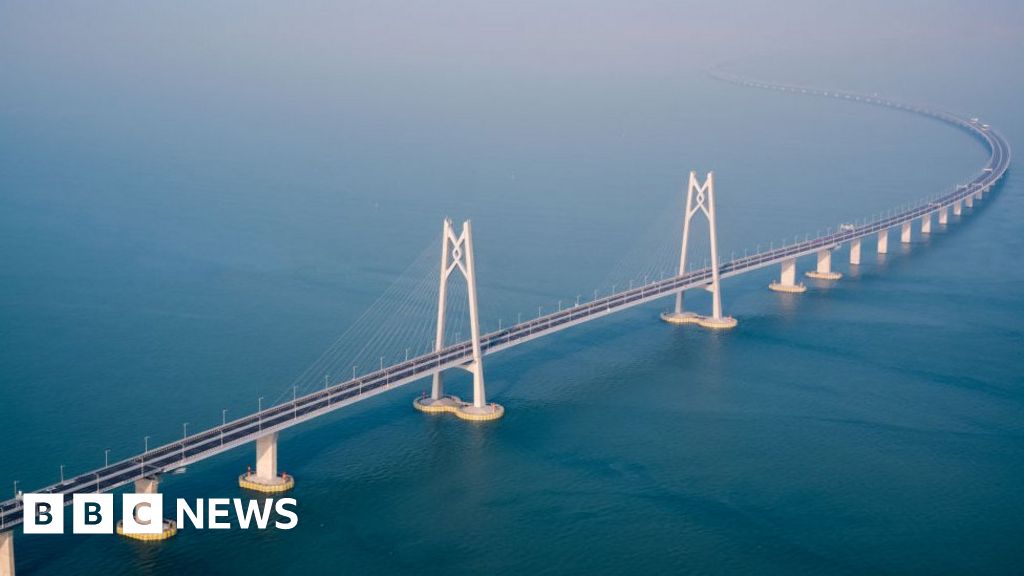
[ad_1]

Copyright of the image
Getty Images
China has been working on the bridge since 2009
The longest bridge in the world crossing the sea is scheduled to open Tuesday, nine years after the start of construction.
The bridge, which includes its access roads, extends over 55 km and connects Hong Kong with Macao and Zhuhai City, mainland China.
Chinese President Xi Jinping will attend Tuesday's opening ceremony on the Zhuhai side.
The bridge cost about $ 20 billion (15.3 billion pounds), but critics claimed that it was a "white elephant" useless.
Construction has been hampered by security concerns – at least 18 workers have died in the project, officials said.
The bridge will be officially open to regular traffic on Wednesday.
What is the particularity of this bridge?
The crossing connects three major coastal cities of southern China – Hong Kong, Macao and Zhuhai.
The bridge, designed to withstand earthquakes and typhoons, was built with 400,000 tons of steel, enough to build 60 Eiffel towers.
About 30 km of its total length crosses the sea from the delta of the Pearl River. To allow the passage of the ships, a section of 6.7 km in the center sinks in an underwater tunnel connecting two artificial islands.
Copyright of the image
Getty Images
One of two artificial islands built as part of the multi-billion dollar project
The remaining sections are connecting roads, viaducts and ground tunnels connecting Zhuhai and Hong Kong to the main bridge.
- Opening of the longest sea bridge in the world
- The longest glass bridge in the world visited by thousands of people every day
Why was it built?
China plans to create an enlarged region including Hong Kong, Macau and nine other cities in southern China.
Copyright of the image
Getty Images
The region currently has 68 million inhabitants.
In the past, travel between Zhuhai and Hong Kong took up to four hours – the new bridge will reduce that time to 30 minutes.
Can any one cross the bridge?
No. Those who want to cross the bridge must obtain special permits, allocated by a quota system. And all vehicles will pay a toll.
As the bridge is not serviced by public transport, private shuttles will also make the journey. There is no rail link.
Authorities initially estimated that 9,200 vehicles would cross the bridge each day. They then lowered their estimates after the construction of new transportation networks in the region.
What do people say about it?
The project has been heavily criticized.
The bridge has been dubbed the "bridge of death" by some local media. At least nine workers from Hong Kong have died and officials told BBC News Chinese that nine more had died on the continent.
Hundreds of workers were also injured during construction.
Copyright of the image
Getty Images
At least 18 people died while working on the bridge
The impact on the environment has also raised concerns.
Environmental groups say the project could have caused severe damage to marine life in the area, including the very rare Chinese white dolphin.
Copyright of the image
AFP
According to environmental groups, it is rare to see Chinese white dolphins around the bridge after years of construction
The number of dolphins seen in Hong Kong waters has dropped from 148 to 47 in the last 10 years, and they are now absent from the waters near the bridge, according to the branch of Hong World's Wildlife Fund (WWF). Kong.
"The project has caused irreversible damage to the sea," said Samantha Lee, deputy director of ocean conservation at WWF. "I'm afraid the number will never increase again."
Will he offset his costs?
The construction of the bridge, surrounding connecting roads and artificial islands costs $ 20 billion, with the main bridge alone costing $ 6.92 billion.
Chinese authorities have said that this would generate up to 10 trillion yuan ($ 1.44 billion) for the economy, but a Hong Kong lawmaker has questioned this figure.
"I'm not sure either that the bridge can be maintained so few cars use it," Tanya Chan told BBC News Chinese.
"I'm pretty sure we will never win this [construction cost] return."
According to a BBC Chinese estimate, the bridge will only bring in $ 86 million worth of tolls per year.
In fact, the maintenance costs of the bridge would already remove one third of these revenues.
Critics have called the bridge a "big white elephant" that guarantees no economic return. Others have said that its main purpose is symbolic: to ensure that Hong Kong is physically connected to the continent.
Additional report by Lam Cho Wai of the BBC